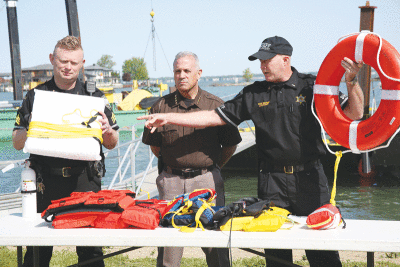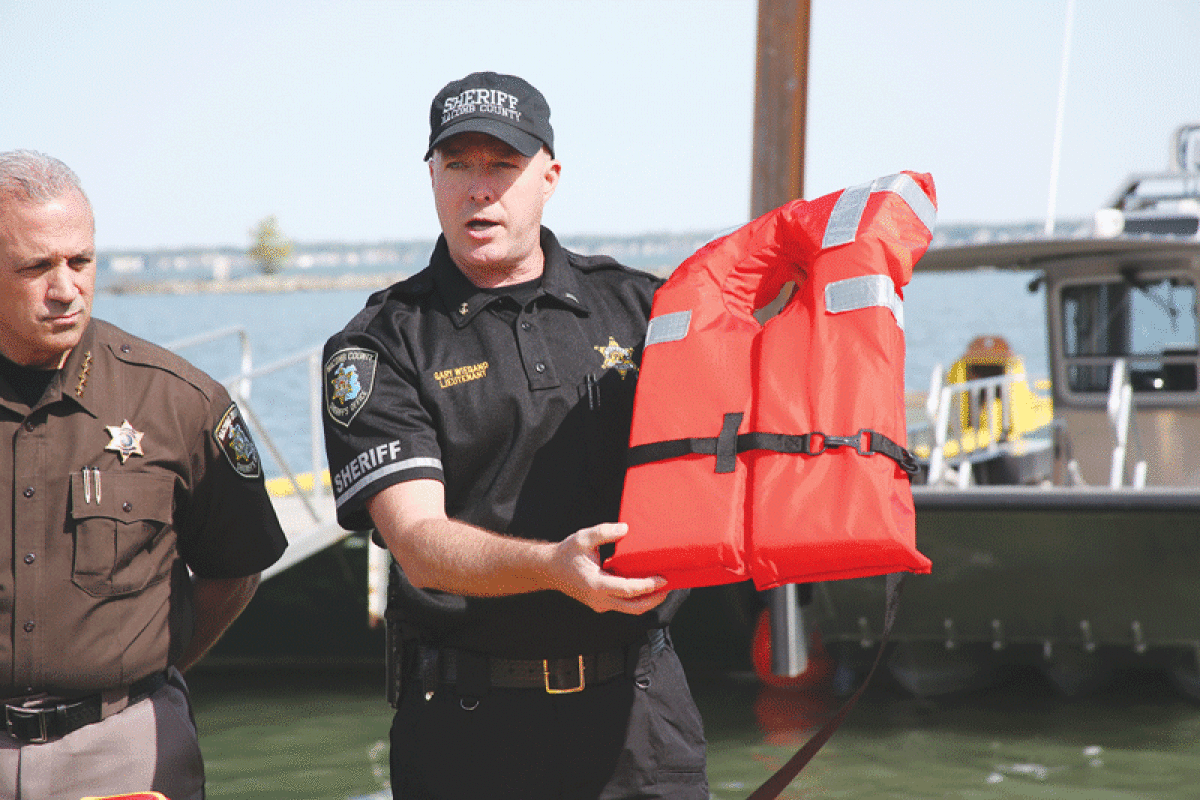
Pictured left to right, Sgt. Jamie Bagos, Sheriff Anthony Wickersham and Lt. Gary Wiegand, of the Macomb County Sheriff’s Office, showed off a variety of safety equipment at a boating safety press conference on May 25. Bagos and Wiegand hold two versions of a Type IV throwable device.
Photo by Dean Vaglia
MACOMB COUNTY — As the summer heats up and vessels embark into Lake St. Clair, fun in the sun is the first thing on any boater’s mind.
But tragedy can strike at any moment, which is why Macomb County Sheriff Anthony Wickersham and the Macomb County Sheriff’s Office Marine Division is reminding lakegoers to practice safe and legal boating.
First things first: Make sure your boat works.
“Before you get on your boat, make sure that vessel is operational,” Wickersham said. “Make sure your vessel is in good condition and that you have all the safety features that are needed.”
Everyone on board needs a life vest rated by the U.S. Coast Guard for open water.
“Boat owners, you are responsible for who you take out on your boat,” Lt. Gary Wiegand said. “Be mindful of the alcohol and remember passenger safety is your responsibility.”
Type I and Type II life jackets provide the necessary buoyancy for open water such as Lake St. Clair. Type V jackets — which inflate upon making contact with water — are acceptable but must be worn at all times to avoid being fined due to the intricate triggering mechanism.
Even if a life vest is worn, having a Type IV throwable device to pull people back into the water is legally required. For those who want to be safety conscious, having a rescue line is a good piece of equipment to add.
“What I always recommend is you have some type of rescue line,” Wiegand said. “Reason being the intended use of this is to throw (it to) somebody in the water so you can help self-rescue that person. The rescue line helps bring that person back.”
If you decide to swim deep in the lake, leaving a Type IV out on a rescue line will let it flow with the current and make it readily available to swimmers.
As for who can be captain, only certain people are legally allowed to operate a boat.
“To operate a personal watercraft, anyone born after Dec. 31, 1978, has to have a boater safety card,” Wiegand said. “Think about that date, think about that age range; basically, if you were born in 1979 or later you have to have (a card) to operate a PWC. It’s just like a driver’s license for a card. You have to have one.”
Youth ages 14 and 15 need parental supervision to operate a boat, and anyone who is 13 or younger is barred by law from operating one.
It is important for the boat to be registered to its proper owner in case salvage retrieval needs to be done.
“If something happens to that boat — if it drifts off the dock or is in an accident or sinks in the worst-case scenarios — we know who to look for,” Wiegand said.
Having an anchor is another important part of boating, and making sure the anchor works properly is even more important.
“Last year, unfortunately, in the Macomb County portion of Lake St. Clair, we had two drownings,” Wiegand said. “These drownings could’ve been avoided if the person had their boat anchor. In both these situations people decided to go swimming off of a vessel that was not anchored, and they could not swim back to the boat as the current took it away, causing a drowning.”
If you need assistance, make sure you have charged cellphones to call 911. When Macomb County Sheriff’s Office dispatchers receive the call, they will be able to retrieve your coordinates to send a Marine Division boat your way. Their boats are equipped with FLIR heat-seeking cameras, sonar, radar and firefighting equipment. The Marine Division takes on additional help during the summer with around 90 marine safety officers, including volunteers and reserves.
For more information about how to boat safely, visit michigan.gov/dnr/things-to-do/boating/rules-and-regs.
The Department of Natural Resources also holds boater safety classes; www.boat-ed.com to register.
 Publication select ▼
Publication select ▼





















